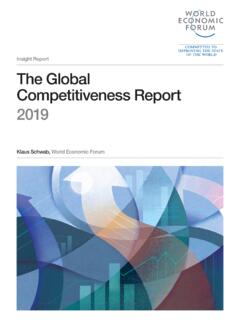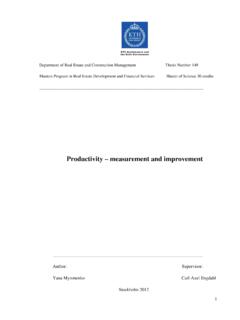Transcription of Productivity and Efficiency Measurement in Agriculture
1 Productivity and Efficiency Measurement in Agriculture Literature Review and Gaps Analysis Publication prepared in the framework of the Global Strategy to improve Agricultural and Rural Statistics February 2017 Productivity and Efficiency Measurement in Agriculture Literature Review and Gaps Analysis Table of Contents 5 6 1. Introduction and 7 2. Basic definitions and 10 What is agricultural Productivity ?.. 10 Total factor Productivity and partial 14 Technical 16 Economic Efficiency and 19 3. Measuring Productivity in 24 Measuring agricultural 24 Quality-adjusted inputs in agricultural Productivity Measurement .
2 26 Land 27 Labour 31 Capital 35 Productivity of intermediate 39 Aggregation of Productivity 40 4. Measuring technical Efficiency in Agriculture .. 46 46 Measuring and decomposing Productivity growth using Malmquist 47 Superlative indices 49 Data Enveloping 49 Parametric approaches to Efficiency 52 5. Agricultural Productivity and farm 58 Productivity and farm 58 Labour Productivity and farm 59 Land Productivity and farm 62 Capital Productivity and farm 63 6. United States Department of Agriculture Productivity measures: a case 65 65 Productivity 65 Analytical 69 70 Quality assessments and 70 70 7.
3 71 73 List of Figures, Tables and Boxes Figures 1 Technical Efficiency and Productivity : an 19 2 Economic Efficiency : an 20 3 Construction of the production frontier using Data Envelop 50 Tables 1 Characteristics of Labour Input for Productivity Measurement (USDA-ERS).. 32 2 Capital Measurement methods of the OECD Capital 37 Boxes 1 The Malmquist Productivity index and its 48 2 Determining the best-practice frontier using data envelopment 51 3 Measuring and explaining technical Efficiency of rice growers in 57 5 Preface This literature review and gaps analysis is undertaken in the context of the research line on the Measurement of agricultural Productivity and Efficiency of the Global Strategy to Improve Agricultural and Rural Statistics.
4 It seeks to define the different concepts and present the main Measurement methods for agricultural Productivity and Efficiency . It does not intend to provide an exhaustive and detailed description of each method and its theoretical grounding. Instead, this review and gaps analysis focuses on the most common ones, identifying the challenges associated with implementation of them, especially with respect to data requirements. This activity, as with all the other research lines of the Global Strategy, is aimed at improving the capacity of developing countries in the provision of quality statistics on the agricultural and rural sector for which Productivity is a significant and policy-relevant domain.
5 In this perspective, the present literature review focuses on the challenges of Productivity and Efficiency Measurement faced by developing countries, which, as many authors have pointed out, have led to missed estimates of overall agricultural Productivity and its driving factors. This review relies as much as possible on studies and papers that have focused on developing countries, providing concrete examples of the implementation of Productivity and Efficiency Measurement . 6 Acknowledgements The present document has been prepared by Aicha Mechri, Peter Lys and Franck Cachia, International Consultants for the Global Strategy to Improve Agricultural and Rural Statistics at the Statistical Division of the Food and Agriculture Organization of the United Nations (FAO).
6 We are greatly indebted to the members of the Expert Group on Agricultural Productivity and Efficiency Measurement , who reviewed intermediate versions of this document and provided extremely relevant comments, suggestions and We would also like to thank Flavio Bolliger, Research Coordinator of the Global Strategy, for providing essential guidance on the content and structure of this literature review and gaps analysis and for reviewing in detail the intermediate drafts. All remaining errors are of the sole responsibility of the authors of this document.
7 1 Special thanks to Sun Lin Wang, Keith Fuglie and Richard Nehring from the USDA-ERS, Patrick Chuni from the Central Statistics Office of Zambia, Martin Beaulieu and Weimin Wa n g from Statistics Canada, Rauschan Bokusheva from OECD and Sergio Gomez y Paloma, Pascal Tillie, and Kamel Louhichi from the EU-JRC, for their participation to the workshop that was held in Washington in December 2016 and for their contributions to the literature r e v i e w. 7 1 Introduction and Purpose Agricultural Productivity and Efficiency is at the centre of many of the debates, policies and measures concerning the farming sector.
8 The emphasis placed by the Sustainable Development Goals on agricultural Productivity underlines the many reasons for which additional research on statistical frameworks for Productivity and Efficiency targeted to developing countries is necessary. Information on agricultural Productivity is related to several of the Sustainable Development Goal indicators, in particular: Indicator : Volume of production per labour unit by classes of farming/pastoral/forestry enterprise size; Indicator : Average income of small-scale food producers, by sex and indigenous status; Indicator : Proportion of agricultural area under productive and sustainable Agriculture .
9 In parallel to global initiatives, such as the 2030 Agenda for Sustainable Development, several countries have introduced policies to improve agricultural Productivity , especially in countries where Agriculture is a major economic sector and the Productivity gap among the primary sector and other industries and services is the widest. Enhancing Productivity in Agriculture is important because of its effective contribution to poverty reduction through better food security and higher farm incomes. The central role of agricultural Productivity in the economic and social agenda of developing countries was reinforced by the Malabo Declaration of June 2014,2 which puts agricultural Productivity growth at the centre of the objective of Africa to achieve Agriculture -led growth and fulfil its targets on food and nutrition security.
10 In the Declaration, it is stated that in order to end hunger in Africa by 2025, at least a doubling of agricultural Productivity is needed from current levels. 2 The Malabo Declaration on Accelerated Agricultural Growth and Transformation for Shared Prosperity and Improved Livelihoods (26-27 June, 2014). 8 In this context, proper statistical frameworks are required to monitor progress towards achieving national, regional or global targets on agricultural Productivity . Research on the Measurement of agricultural Productivity is not new and can be traced back to the classical theory of economic growth.
















